Now, that i am in part 7, the last part of the VMware vSphere 6.0 tutorial, i must admit that it is getting more interesting. So far, these parts have been already covered.
- An introduction of Data Center Virtualization
- Components of VMware vSphere 6.0 – part 1 which include an overview of Vsphere 6.0, its architecture, Topology and configuration maximums.
- Components of VMware vSphere 6.0 – part 2 which include an introduction to vCenter servers and its features.
- Components of VMware vSphere 6.0 – part 3 which include Shared Storage, Shared Protocols, Data Stores, Virtual SANs and Virtual Volumes
- Components of VMware vSphere 6.0 – part 4 which include Networking feature in vSphere, Virtual Networking, Virtual Switches, Virtual Switch types and Introduction to NSX
- Components of VMware vSphere 6.0 – part 5 which include vSphere Resource management features, vMotion, DRS, DPM, Storage vMotion, Storage DRS, Storage I/O control and Network I/O control
- Components of Vmware vSphere 6.0 – part 6 which include vSphere availability features, vSphere data protection, High Availability, Fault Tolerance and vSphere replication.
In this post, we will get into the following parts:
- Data Center Virtualization products overview
- vSphere with Operation Management
- vRealize suite
- Software defined storage – Virtual SAN
- Software defined networking – NSX
- Big Data Extensions – BDE
- VMware Integrated OpenStack
- Cloud Services – vCloud Air
- EVO:Rack and EVO:Rail
Data Center Virtualization Products overview
The goal of DCV products is to help in the flexibility of computer, storage and networking. These are the various DCV products:
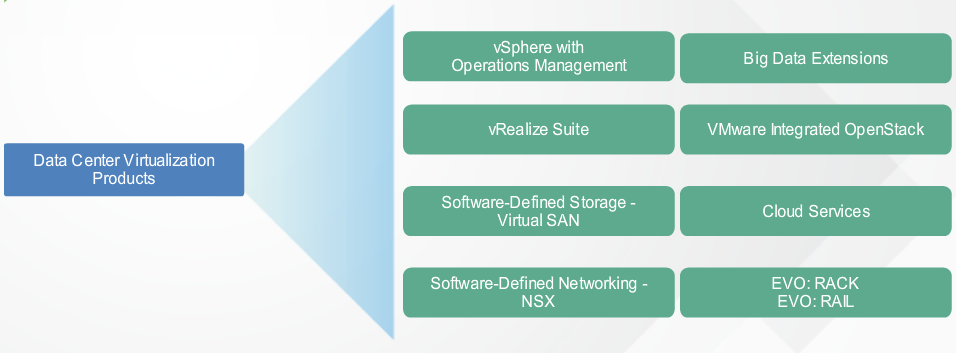
vSphere with Operations Management
vSphere with Operations Management offers the virtualization platform with critical operational enhancements in Performance Monitoring andCapacity Management. It is designed for businesses of all sizes and allows them to run applications at high service levels and maximized hardware savings to higher capacity utilization and consolidation ratio. vSphere with operations management provides availability services and policies with simplicity and flexibility for any application from legacy to next generation application such as Hadoop that require intense resources. The platform can also be tuned to meet the performance needs of low latency applications. vSphere with Operations management also reduces the cost and complexity of managing Business Continuity and Disaster Recovery with layered protection against service outages and data loss. The platform provides fast and efficient data recovery for virtual machine, in addition to replicating and running virtual machine to another location. With predictive analytics and smart alerts on the house of the virtualized systems, vSphere with operations management enables proactive identification and remediation of system issues with dynamic threshold that automatically adapt to environments to provide fewer and more specific alerts. vSphere with operations management makes it easier to optimize and manage capacity planning. It allows you to reclaimed over-provisioned capacity, increase resource utilization and eliminate the need for scripts and spreadsheets
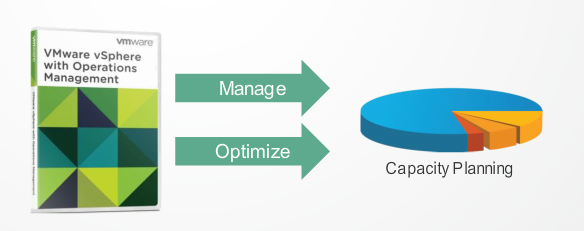
vSphere with Operations Management is a combination of vSphere and vRealize operations standard editions. vSphere with operations management editions is available in the following three editions:
- vSphere with Operations Management Standard – Server consolidation, business continuity and insight into workload capacity and health management.
- vSphere with Operations Management Enterprise – Resource Load Balancing and insight into workload capacity and health management.
- vSphere with Operations Management Enterprise Plus – Enhanced application availability and performance insight into workload capacity and health management.
There is another product called vSphere with Operation Management Acceleration Kits which comes into the following versions:
- vSphere with Operations Management Standard AK – Server consolidation, business continuity and insight into workload capacity and health.
- vSphere with Operations Management Enterprise AK – Resource Load Balancing and insight into workload capacity and health
- vSphere with Operations Management Enterprise AK Plus – Enhanced application availability and performance insight into workload capacity and health
There are add-ons options with vSphere Operations Management such as vRealize operations Insight, to perform advanced operations management for vSphere Operations Management.
vRealize suite
VMware vRealize suite is a cloud management platform purposely built for the hybrid cloud. It delivers and manages infrastructure and application quickly while maintaining IT control. vRealize suite provide a comprehensive management stack on IT services on VMware vSphere and other hypervisors. It extends a unified management experience to external cloud service providers such as VMware vCloud AIR and AWS web services or OpenStack based private and public cloud. With vRealize suite, businesses get the agility and speed needed to maintain competitive advantages. At the same time IT gets the control and efficiency needed to manage and uptime, performance, compliance and cost effective infrastructure and applications. vRealize suite consist of the following products:
- VMware vRealize Automation – vRealize Automation provides a secure portal where authorized administrators, developers or business users can request new IT services and manage specific cloud and IT resources, while ensuring compliance with business policies. Request for IT services such as infrastructure, applications and desktop are processed through a common-service catalog to provide a consistent user experience. vRealize automation improves cost control by exposing the cost of cloud resources and by providing simplified resource management including reporting on capacity use.
- VMware vRealize Operations – vRealize operations is built on a scale-out, resilient platformed designed to deliver intelligent operational insights to simplify and automate management of application and infrastructure across virtual, physical and cloud environments. With vRealize operations, IT organizations of all sizes can improve performance, avoid business disruptions and become more efficient with comprehensive visibility across applications and infrastructure in one place.
- VMware vRealize Log Insight – vRealize Log Insight delivers real-time log management for VMware environments with machine learning-based Intelligent Grouping, High Performance Search and better troubleshooting across physical, virtual and cloud environments. It has an intuitive, easy to use and graphical interface for simple interactive searches as well as deep analytical queries. vRealize Log Insight is best suited for your VMware environment as it has a built-in knowledge and native support for vSphere.
vRealize Operations : Introduction
vRealize Operations is a scalable and resilient platform. It is a part of the vRealize Suite products. vRealize Operations provide control over performance capacity and configuration with predictive analytics to add in pro-active actions and policy based automation. The key features of vRealize operations include the following:
- Operation Dashboard – The Operation Dashboard feature provides ‘at a glance-views’ into health, risk and efficiency data of your virtual infrastructure.
- Health and Workload view – is a feature that identifies anomalies, faults and stressed workloads that can impact the performance and health of the infrastructure.
- Workload Details view – is a feature provides in-depth analysis of the factors that impact the performance and health of virtual machines, hosts, datastores and clusters.
- Proactive Smart Alert – is a feature which enables you to perform root cause analysis of potential issues. This feature notifies the end users of issues in advance before they are actually impacted.
- Automated correlation of change events – is a feature that enables you to track back the cause of reduction of performance and health and identify the changes in the infrastructure or those inside the guest operating system. This feature facilitates better configuration management.
- Heat Map Views – is a feature that provides visibility into all areas of your infrastructure and enables you to identify resource constraints and bottlenecks.
- Capacity Trending and analysis – is a feature that provides insight into the current and future resource needs and usage. The feature enables informed capacity management and planning through performance trends, forward-looking projections and extended forecast.
- Right-Size virtual machines – is a feature that helps you to reclaim unused resources to optimize consolidation ratios and virtual machine density without impacting performance
- Capacity reporting feature – is a feature that enabled automatic generation and dispatch of capacity reports in a variety of formats.
- Remediation Actions – is a feature that enables problem identification and resolution without the need to exit vRealize Operations 6.0
- Fully customizable Symptoms, Alerts and Recommendations – is a feature that enables building and bundling of your own customized symptoms into specific alerts that helps your IT staff by defining your own recommendations.
vRealize Operations: Virtual Machine Architecture
VMware vRealize Operations Architecture is a reliable and scalable model that can be use to cross different kinds of environments ranging from smart and wide enterprise organisations. Each install of the VMware vRealize Suite Operations include the entire software stack that includes:
- User Interface – Are web applications services based on Apache Tomcat
- Collector – The collector component connects to one or more controller component and sends the collected data.
- Controller – is responsible for placing or mapping the data across the nodes in the cluster.
- Analytics – Receives data from the controller components, caches the collected data and processes the collected data.
- Persistence – takes cached data and writes the data to disks
- Databases – Data is stored in XML based databases or xDB – A file system database (FSDB) and a vPostgres database
This box refers to the Virtual Machine which runs the full stack of software. Applications disciplines such as Capacity, Performance, Change Management and Compliance works across the stack. The rest of the applications disciplines are enables as common services.
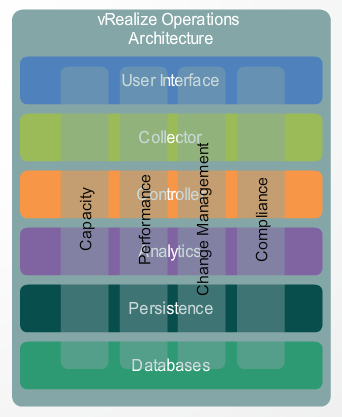
vRealize Operations : High level Architecture
vRealize Operations collects data from many different sources such as vCenter Server, vCenter Configuration Manager or vCloud Director. The vRealize Operations Analytics virtual machine processes the collected data and presents the result through out the UI virtual machine. Possible UI are the vRealize Operations vSphere UI and the vRealize Operations Manager Customs UI which is only available in the VMware vRealized Advanced and Enterprise Editions. vRealize Operations also features an Admin UI to perform administrative tasks. The monitored resources and collected metrics requires certain computing resources. This should be taken into account when deploying the virtual machine. vRealize Operations is designed as Enterprise solutions. So planning and preparing your environment is critical to successful deployment. You need to take factor like Environment Size, Landscape and Complexity into account. The vRealize Operations architecture needs to take into account how large the environment is including the number of applications, data sources, resources and metrics, the physical environment distribution and the number of users
Software defined storage – Virtual SAN
VMware Software Defined Storage (SDS) transformed storage on virtualized environment by aligning it with applications demands. The hypervisor matches the demands from virtualized applications with the storage supply, makes intelligent placement decisions and optimizes Ongoing Adjustments.
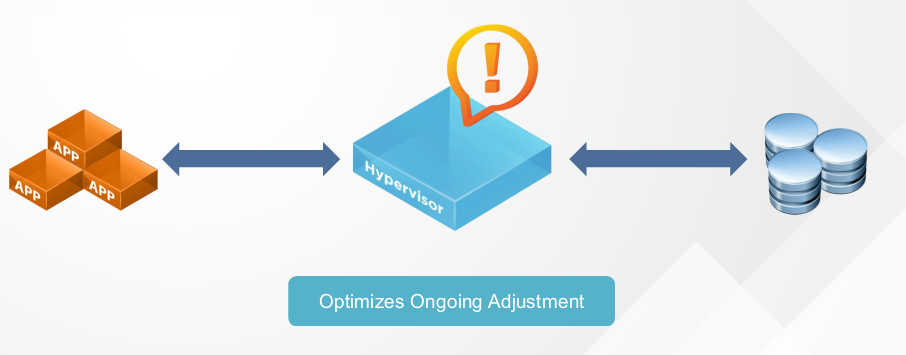
Virtual SAN is the SDS for the SDDC. Virtual SANs hypervisor converged architecture enables storage and compute to run on the same physical hosts with minimal overhead. It can seamlessly integrate with the vSphere web client and the entire VMware stack to simplified management. When enabled Virtual SAN works together with virtual machines storage policies. Virtual SANs monitors and reports on the policy compliance during the life cycle of the virtual machine.
Software defined networking – NSX
Software Defined Networking – SDN enables you to network with virtual machines on the same way which you use to do with physical machines. You can also built complexed network within a single ESXi hosts or across multiple ESXi hosts for production deployments or for development and testing purposes. NSX network virtualization is a transformed architecture from VMware that makes it possible to create and run an entire networks in parallel on top of existing hardware. This result in faster deployment of workloads as fast as agility and face of increasingly dynamic data centers. NSX reproduce the entire networking environment in software. You can deploy NSX non disruptively on top of your existing physical infrastructure. NSX network virtualization allows you to treat your physical network as a pool of transport capacity. NSX provides you with a platform for advanced networking and security services. NSX allows you to create a network pool of capacity that can be allocated, utilized and repurposed on demand. It decouples the network from the underlying hardware and applies virtualization principles to networking infrastructure. It also deploys network in software that are fully isolated from each other as far as other changes in a data center.
Big Data Extensions – BDE
vSphere Big Data Extension – BDE is a feature in vSphere to support big data in Hadoop or clouds. BDE provided an integrated set of management tools to help enterprise deploy, run and manage Hadoop on the vSphere platform. VMware introduces BDE as a commercially supported version of project Serengeti design for enterprises seeking VMware support. BDE enables customers to run clustered scalar Hadoop applications on the vSphere platform delivering all the benefits of virtualization to Hadoop users.
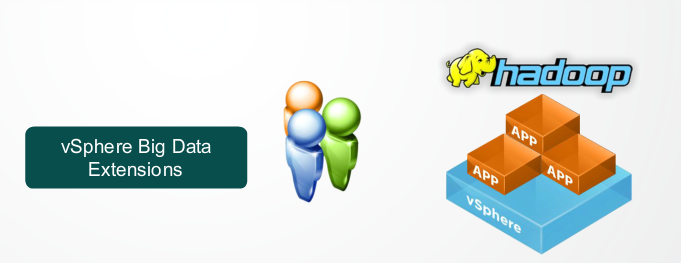
BDE delivers operational simplicity with an easy to use interface, improved utilization through compute elasticity and a scalable big data platform to satisfies business changing requirements. A few feature of BDE include:
- Integrate with vCenter for automated deployment of Hadoop clusters.
- Provide self service of Hadoop clusters in the private cloud with vCloud Automation Center.
- Integrate with management tools to manage infrastructure and perform Hadoop installation.
- Elastically scale compute and data separately.
VMware Integrated OpenStack
VMware Integrated OpenStack – VIO enables IT administrators to deploy and manage a production grade OpenStack quickly and easily on top of their VMware infrastructure. It provides key administration capabilities including install, upgrade, troubleshooting and cost visibility to various VMware management tool. A few key feature of VIO include:
- Streamlined deployment using vSphere web client
- Seamless upgrade or patch
- Available free of charge for use for all vSphere Enterprise Plus Customers
- Highly scalable network virtualization solution through NSX
- Simple, high performance and resilient storage using Virtual SAN
- Predefined workflows for automating operations such as adding or removing capacity
A few advantage of VIO include:
- Most robust and production proven hypervisor
- Advanced virtualized network services with massive scale and throughput
- Advanced storage policies using virtual SAN and vSphere virtual volume
- Works with any vSphere validated storage
Cloud Services – vCloud Air
vCloud Air is an extension of the of the SDDC that is designed to deliver a true hybrid cloud.

This service supports existing workloads and 3rd party application as well as new application development giving administrators a common platform to seamlessly extend their data center to the cloud. Administrators can leverage the tools and processes that they are familiar with and move the existing applications and services to the cloud without having to re-architect the infrastructure. vCloud Air offers a seamlessly networking layer between your data center or private cloud and vCloud Air and common management tools for on-premises and off-premises management of workload. Application and data are completely mobile from your premises to vCloud Air and back to premises on demand. It allows you to stay in full control of the cloud environment using your current staff, processes, tools and automatation.
EVO:Rack and EVO:Rail
VMware EVO Rack
VMware EVO Rack is a hyper converged infrastructure product that can dramatically simplified how companies buy, deploy and operate SDDCs.
- It help organizations rapidly provision applications and services at data center scale.
- EVO Rack meets the increasing demands of private clouds at medium to large enterprises.
- It can run on a range of pre-integrated hardware configurations ranging from Open Compute Project based hardware designed to industry designed OEM servers and converged infrastructure.
VMware EVO Rail
VMware EVO Rail is another hyper converged infrastructure product
- That would help customers to streamline the deployment and scale-out of software-defined IT infrastructure
- It is also the first solution in a family of hyper converged offerings from VMware
- EVO Rails target users in the mid-market and enterprise segments.
It is ideally suited for use CASES such as desktop infrastructure or VDI as well as remote office, branch office for industries such as financial services, Federal, Healthcare, Higher Education, Insurance, Oil and Gas and Retail.









